Commonwealth Aboriginal and Torres Strait Islander Workforce Strategy 2020-2024
Ministers’ foreword
We acknowledge the Traditional Custodians of the land and pay our respects to Elders past and present. We acknowledge all Indigenous Australians and their continuing connection to Country, culture and community.
We also recognise the immeasurable contribution Aboriginal and Torres Strait Islander employees make to the fabric of Australian society and the Australian workforce. The Commonwealth Aboriginal and Torres Strait Islander Workforce Strategy 2020-2024 (the Strategy) is a strong commitment and investment in Australia’s future.
More than 240,000 Australians work for the Commonwealth public sector in a wide variety of roles. This presence, including in rural and regional Australia and internationally, gives the Commonwealth huge leverage as an employer. The Strategy sets out a bold and aspiring vision for improving the employment opportunities and experiences for Aboriginal and Torres Strait Islander employees across the Commonwealth public sector. Successful implementation is key, and will require greater portfolio collaboration, stronger focus on delivery and improved regional relationships. This will ensure the Commonwealth public sector delivers leading government services, policies and programs that result in better outcomes for Aboriginal and Torres Strait Islander Australians.
The Australian Government aims to improve the lives of all Aboriginal and Torres Strait Islander Australians. The Australian Government contributes to improvements through the delivery of better health, education and employment outcomes for Aboriginal and Torres Strait Islander people, and works to eliminate the gap between Indigenous and non-Indigenous Australians through Closing the Gap initiatives. The Strategy will also contribute to annual Closing the Gap reporting targets.
The Strategy will guide the Commonwealth public sector as we walk together in partnership, investing in the future to create a diverse workforce that will truly deliver the very best outcomes for all Australians.
The Hon Greg Hunt, MP
Minister for Health Minister Assisting the Prime Minister for the Public Service and Cabinet
The Hon Ken Wyatt AM, MP
Minister for Indigenous Australians
Australian Public Service Commissioner’s message
I would like to acknowledge the Traditional Owners and Custodians of the land on which we operate. I pay my respects to the Elders, past, present and emerging, acknowledging their history and continued connection to Country.
The Commonwealth Aboriginal and Torres Strait Islander Workforce Strategy 2020–2024 (the Strategy) sets the direction for Commonwealth agencies (non-corporate and corporate Commonwealth entities and the Australian Defence Force) as employers, investing for the future.
This Strategy aims to accelerate improvements in ‘closing the gap’ in social and economic outcomes between Indigenous Australians and non-Indigenous Australians by building on the achievements of the previous Commonwealth Aboriginal and Torres Strait Islander Employment Strategy 2015–2018.
The evaluation findings of the 2015–2018 Strategy identified four key areas to strengthen a future strategy:
- re-consider target settings
- focus on building Career Pathways
- strengthen Career Development, and
- embed cultural knowledge and understanding into workplace cultures.
As employers, all Commonwealth agencies have a responsibility to contribute to the Closing the Gap priority—Economic Development for strong Aboriginal and Torres Strait Islander workforce participation1. In fulfilling this responsibility, the Commonwealth is well placed to offer career pathways into and across the public sector to better support Aboriginal and Torres Strait Islander employees through career development, retention and advancement. This will play a part in ‘closing the gap’ between Indigenous and non-Indigenous Australians in life expectancy, employment and educational outcomes and productivity.
There are also significant benefits to agencies and the broader public service from this approach. Workplace environments that demonstrate cultural integrity drive better policy development and service delivery outcomes to better meet the needs of the Australian community.
Mr Peter Woolcott AO
Commissioner
Australian Public Service Commission
National Indigenous Australians Agency CEO’s message
The National Indigenous Australians Agency (NIAA) acknowledges the Traditional Owners and Custodians of Country throughout Australia and acknowledges the continuing connection to land, waters and community. We pay our respects to the people, the culture and the Elders, past, present and emerging.
The Commonwealth Aboriginal & Torres Strait Islander Workforce Strategy 2020–2024 (the Strategy) provides an important framework to increase Indigenous employment outcomes across the Commonwealth public sector.
While we know there was a significant increase in overall employment numbers between 2015 (2.2 per cent) and 2018 (2.9 per cent), this was largely at the lower classification levels. Further work needs to be done to increase representation in middle management, executive level and senior executive leadership roles. Importantly, the objectives of this Strategy also focus on career development and retention, which will be critical to making sustained progress.
Improving the representation of Indigenous Australians at all levels is vital to building a workforce that reflects the communities we serve and provides lived experience that can help shape Australian Government policies to improve outcomes for Indigenous Australians. It will also enrich our agencies’ connection to and understanding of the world’s oldest living culture and provide visible role models for emerging Aboriginal and Torres Strait Islander leaders within the Commonwealth and across the community.
I encourage all Australian Government agencies to implement the strategic focus areas identified in this Strategy and continue to build on the collaborative efforts required to meet the Indigenous employment targets.
Ray Griggs AO, CSC
Chief Executive Officer
National Indigenous Australians Agency
Lessons learnt
While progress has been made, the evidence shows systematic change has been slow and needs to accelerate.
Over the three year period 30 June 2015 to 30 June 2018, the number of Commonwealth public sector employees who self-identified as Aboriginal and/or Torres Strait Islander, increased from 6,879 to 8,636.
Commonwealth Indigenous workforce

While this is a significant increase in overall numbers, it has largely been at the lower classification levels with no clear promotion or leadership pathways emerging. This has led to an under-representation in middle management, executive level and senior executive leadership roles. This reflects an emphasis on entry-level recruitment as the key way to achieve the 3 per cent representation target in the previous strategy.
Over the same period, the separation of ongoing Aboriginal and Torres Strait Islander employees grew as a proportion of all ongoing employee separations.
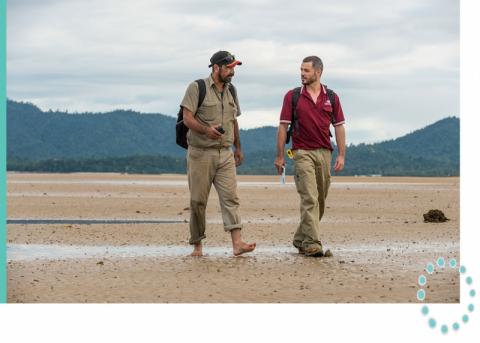
The graph below shows the trends in the Australian Public Service (APS) over the period 2014 to 2018. These trends have continued in 2019.
Separations and engagements of Indigenous APS employees by year (December, 2014–2018)
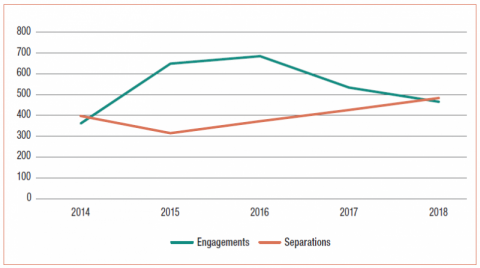
The 2015–2018 Strategy evaluation and consultation identified barriers to successful implementation including:
- Timeliness and complexity of recruitment processes
- Variable levels of support and opportunities for Aboriginal and Torres Strait Islander employees, particularly after the completion of entry level programs
- Issues around retention, and
- A patchy understanding across Commonwealth agencies of Aboriginal and Torres Strait Islander cultures, including:
- the additional pressures, expectations and challenges faced by Aboriginal and Torres Strait Islander employees of ‘walking in two worlds’ while maintaining their cultural integrity; and
- challenges created by the dominant public sector culture and failure to acknowledge the need for change.
The evaluation of the former strategy found key enablers of successful implementation and greater representation of Aboriginal and Torres Strait Islander people at all classification levels included:
- Strong commitment and leadership at senior levels
- Indigenous employee networks
- Reconciliation Action Plan commitments
- Managers’ commitment and cultural competence
- Human resource (HR) support, and
- Connection to agency priorities.
2015–2018 Strategy evaluation: Identified key enablers of success
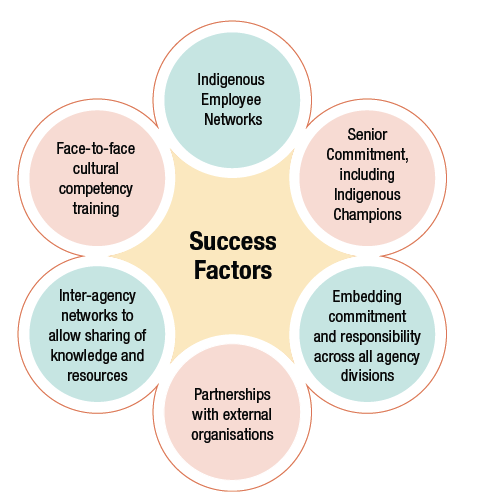
Workplace inclusion
Inclusion in workplaces is achieved when people feel that their whole self is understood, respected for who they are, included at work, and they are not just seen as a one dimensional stereotype. Contemporary literature on diversity and inclusion is increasingly acknowledging the importance of inclusion to create a sense of belonging. Agencies’ Diversity and Inclusion Strategies are considered strategic documents that can help build workplace inclusion.

Commonwealth public sector context
For the purposes of this Strategy, Commonwealth agencies comprises non-corporate and corporate Commonwealth entities and the Australian Defence Force.
It is important to acknowledge the different contexts in which each Commonwealth department and agency operates, and to respect individual employee choices and preferences on the type of work they do and where they are located.
The Commonwealth public sector is a large employer with some 240,000 employees operating in Australia’s capital cities and regional areas across all states and territories, and an international presence. Each Commonwealth public sector workplace has varying levels of maturity in cultural integrity, with workforces comprising different levels of representation of Aboriginal and Torres Strait Islander peoples who are at different stages in their life and career.
A key focus in the implementation of this Strategy will be building on these experiences, sharing ideas and seeking to optimise and leverage opportunities.
In the context of this Strategy ‘should’ is taken to mean better practice.
Objectives
The Strategy will ensure that Aboriginal and Torres Strait Islander employees play a greater role in contributing to building a diverse Commonwealth public sector workforce capable of responding to the needs of the Australian community. Aboriginal and Torres Strait Islander employees will have enhanced capability and thriving careers and be employed in workplaces with greater Aboriginal and Torres Strait Islander cultural capability.
Increased ongoing representation of Aboriginal and Torres Strait Islander employees at all levels of the Commonwealth public sector will be achieved by:
- improving the employee experience for all Aboriginal and Torres Strait Islander employees across the Commonwealth, and
- enhancing the capabilities of the Aboriginal and Torres Strait Islander workforce.

Our strategic focus areas
The strategic focus areas to achieve these objectives are cultural integrity; career pathways and career development and advancement.
Cultural integrity—improving and embedding the understanding of Aboriginal and Torres Strait Islander culture in the workplace to support the development of culturally-safe work spaces and services, and creating a more inclusive Commonwealth public sector.
Careerpathways—diversify and strengthen the pathways into and across the Commonwealth public sector.
Career development and advancement—individual career development and advancement plans supported by targeted development initiatives and advancement opportunities.
Strategic focus areas
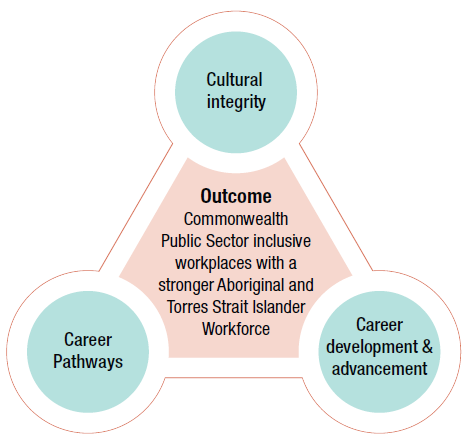
The outcome is for the Commonwealth public sector to have inclusive workplaces with a greater Aboriginal and Torres Strait Islander workforce representation at all classification levels and in all business areas.
A strategic focus on all elements of the Strategy will contribute to the Strategy’s success.
Targeted investment
Workforce data for Australian Public Service (APS) agencies at the end of 2018, shows Aboriginal and Torres Strait Islander employees were significantly over-represented at the trainee to APS 4 classifications and significantly under-represented at middle management, executive level leadership and senior executive leadership roles, as can be seen in the graph below.
Profile of APS career stages—Indigenous and non-Indigenous

Source: APSED
Over the five years of the Strategy all Commonwealth agencies need to continue to invest for the future by building a talent pipeline through direct recruitment, professional development and decreasing the relative separation rates of Aboriginal and Torres Strait Islander employees.
Recognising and valuing investment in individuals through Internships and Cadetships, providing early career pathway opportunities with an option to progress into Graduate programs or an alternative pathway, are important contributions to building a future focussed talent pipeline.
A strategic focus on consolidating existing entry level recruitment programs to remove duplication, inefficiencies and ensuring they offer a pathway beyond the program is essential.
At the same time there is a need to increase the number of Aboriginal and Torres Strait Islander employees in middle management, executive level leadership and senior executive leadership roles through ongoing targeted recruitment.
Overall Commonwealth workforce representation targets
The Commonwealth aspires to achieve a stretch target of 3 per cent Aboriginal and Torres Strait Islander employee representation for the Senior Executive Service by 2024, the final year of the Strategy.
To achieve the desired outcome, the Commonwealth should aim to invest in Aboriginal and Torres Strait Islander representation at the APS 4 to APS 6 levels (or equivalent) to 5 per cent by the end of 2022, this will help build the pipeline; and representation of 5 per cent at the Executive Levels 1 and 2 by the end of 2024.
Initially this will be achieved through targeted recruitment with a longer term focus on developing employees within the public sector to enable promotion into the more senior roles.
Commonwealth stretch targets
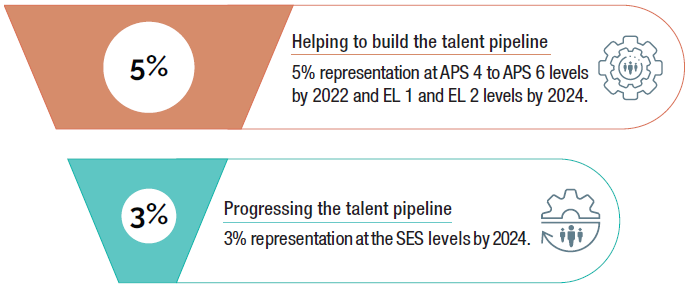
Portfolio workforce representation targets
To support the Commonwealth in building the talent pipeline, each portfolio should aim to achieve a stretch target of 3 per cent Aboriginal and Torres Strait Islander representation at each classification level in their workforce by 2024, the final year of the Strategy.
Portfolio stretch targets

In addition to the workforce representation targets, a strategic prioritisation of efforts is
required by all Commonwealth agencies to:
- increase the cultural integrity of Commonwealth public sector workplaces,
- decrease relative separation rates of Aboriginal and Torres Strait Islander employees, and
- provide tailored and appropriate support for Aboriginal and Torres Strait Islander employees to advance their career, while respecting individual choices.
Individual Commonwealth agencies’ capacity to contribute to the Strategy, including to the broader portfolio and Commonwealth targets, will vary. Those agencies with a strong regional presence and a record of effective initiatives in this area will be critical to further improvement and will provide valuable insights to other agencies. The broad implementation of the strategy will also provide an opportunity for Commonwealth agencies to work together on practical initiatives that are meaningful and fit-for-purpose in the workplace environment or context in which they operate.
The graph below shows the APS Aboriginal and Torres Strait Islander workforce by classification at 31 December 2018, overlaid with a 3 per cent representation at each classification level in the portfolio workforce by 2024.
Current and 2024 target headcount at classification
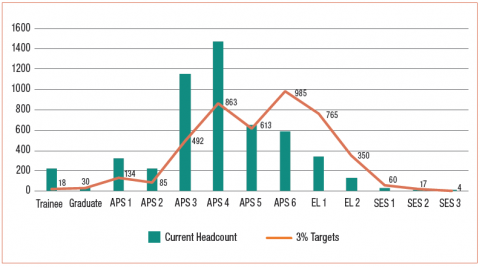
Source: APSED
The effectiveness of the stretch targets will be reviewed as part of an interim evaluation in 2022. The findings of the interim evaluation will inform considerations to any adjustments deemed necessary to the targets to achieve the overall objectives of the Strategy.

Implementation—bringing the strategy to life
Commonwealth agencies will adopt the Australian Government endorsed Implementation Principles for Closing the Gap action plans2 to guide them in the implementation of the Strategy.
A continued shift in mindsets and behaviours will be key to making sustained progress. Inclusive, trauma-informed3 workplaces can contribute to positive workplace experiences that underpin the recruitment and retention of Aboriginal and Torres Strait Islander peoples, while at the same time helping the Commonwealth public sector build a workforce that is capable of responding to the needs of the Australian community.
Effective implementation will require a shift from a narrow focus on a simple representation target to an approach that:
- embeds diversity and inclusion into workplace cultures; creating positive workplace experiences, and
- builds cultural capability in Commonwealth public sector workplaces and employees to increases retention and progression of Aboriginal and Torres Strait Islander employees; and to attract more Aboriginal and Torres Strait Islander peoples to the public sector, including at senior levels.
Commonwealth agencies recognise there is a need to continue building trust with Aboriginal and Torres Strait Islander peoples and their communities. Improving the public service employee value proposition to attract and engage Aboriginal and Torres Strait Islander peoples, together with positive workplace experiences will have a positive impact on retention.
Consistent with broader approaches within the APS, it will be important to value and reward those Aboriginal and Torres Strait Islander employees who are mobile across agencies, sectors and the community, acquiring new skills and experiences.
Agencies should establish strong relationships with communities in regional and remote Australia to better understand the needs, priorities and goals of Aboriginal and Torres Strait Islander peoples and their communities. Where agencies have made inroads into connecting and establishing relationships, this will enhance their efforts under this Strategy.
Meeting the challenge


Priority actions for agencies
Core focus area 1: Cultural integrity
Improving and embedding the understanding of Aboriginal and Torres Strait Islander cultures in the workplace to support the development of culturally-safe work spaces and services.
- Explicitly recognise the value, and embed the voice of Aboriginal and Torres Strait Islander employees into agencies’ work.
- All agencies to develop and implement Reconciliation Action Plans with actions targeted to contribute to reconciliation in the agency and the communities in which it operates.
- Agencies to invest in networking and collaboration with other agencies of similar service or industry focus to build innovation and information sharing networks.
- Support Aboriginal and Torres Strait Islander Employee Networks, and collaborate with other agencies to support networks across the system.
- Implement practical strategies to help develop cultural capability for all employees so that by 2024 all Aboriginal and Torres Strait Islander employees can expect that their manager and their colleagues have received cultural competency training.
- Promote reconciliation amongst all Australians by continuing to acknowledge, promote and guide employees on Aboriginal and Torres Strait Islander cultural events and significant celebrations.
- Embed cultural awareness and capability into all areas of the business of the organisation.
- Selection panel members will need to demonstrate foundation cultural capabilities.
- Selection panels for vacancies advertised as Identified roles or Affirmative Measure —Indigenous employment should have at least one Aboriginal and/or Torres Strait Islander person on the panel.
Core focus area 2: Career pathways
Diversifying and strengthening the pathways in the Commonwealth public sector.
- Targets and actions supporting the Strategy should be integrated into agencies’ workforce planning and strategic documents.
- Agencies to improve their workforce planning capabilities and link this to the career management of their Aboriginal and Torres Strait Islander workforce.
- Agencies to identify the barriers to career advancement for Aboriginal and Torres Strait Islander peoples within their organisation and embed appropriate measures to address these barriers.
- The Australian Public Service Commission (APSC) and agencies will adopt consistent branding for all Aboriginal and Torres Strait Islander recruitment programs, complementing agency specific branding.
- Larger agencies to work collaboratively with smaller agencies within their respective portfolio in progressing Aboriginal and Torres Strait Islander recruitment, development and retention initiatives.
- Agencies and the APSC will review policies and processes to identify and remove barriers for inclusive streamlined recruitment practices.
- Targeted recruitment to engage or promote Aboriginal and Torres Strait Islander peoples into middle management and more senior roles, including through the use of the Affirmative Measure—Indigenous employment.
- Agencies to increase employment and career development opportunities for Aboriginal and Torres Strait Islander peoples in regional and remote Australia.

Core focus area 3: Career development and advancement
Consistent with the expectations for all Commonwealth public sector employees; focus on managers engaging with Aboriginal and Torres Strait Islander employees to put in place individual career development and advancement plans supported by targeted development initiatives and advancement opportunities.
- Agencies develop and articulate a clear employee value proposition for Aboriginal and Torres Strait Islander peoples.
- Managers, supervisors and Aboriginal and Torres Strait Islander employees work together to establish career development pathway plans supporting individual employees to actively manage their careers.
- Agencies to invest in, source and/or develop appropriate professional development initiatives for Aboriginal and Torres Strait Islander employees and managers.
- APSC and agencies to develop links with universities to design bridging programs to assist in supporting Aboriginal and Torres Strait Islander employees with tailored tools and advice to empower them throughout their career journey.
- Provide local, place-based networking events for Aboriginal and Torres Strait Islander employees as a way to facilitate building of local networks across the Commonwealth.
- Establish links and partnerships with the tertiary sector, states and territories and non-government organisations to leverage regional career opportunities; and to attract and recruit Aboriginal and Torres Strait Islander peoples.
- Provide mobility opportunities for Aboriginal and Torres Strait Islander employees to diversify their skill sets, through voluntary moves using secondments, temporary transfers or leave without pay to undertake roles or other activities within and outside the public service, in line with a flexible operating model for the Commonwealth public sector.
- Ensure that when Aboriginal and Torres Strait Islander employees take up mobility options, mentoring and other contact is maintained and that on their return, appropriate recognition is given for the work they have undertaken while away from the agency.
- APSC relevant agencies to develop a proposal for government to establish a regional learning hub with a focus on relevant policy areas.
Monitoring and evaluation
Commonwealth agencies are to establish data collection and reporting mechanisms to monitor their progress towards achieving their portfolio outcomes. Portfolio co-ordinators should be established as a point of contact to co-ordinate bi-annual portfolio reporting requirements to the Secretaries Board through the APSC.
Progress will be measured through a range of quantitative and qualitative mechanisms. Where possible existing data capture processes will be used to avoid any unnecessary administrative burden. The APSC will monitor progress towards achieving the overall objectives of the Strategy.
An interim evaluation of the Strategy implementation will be undertaken in 2022 to measure progress and identify areas of strengths and future priority needs to achieve the outcomes of the Strategy. Consideration will be given to refreshing the Strategy at this time.
A further evaluation will be undertaken in 2024, the final year of the Strategy.
Annual public reporting through the Closing the Gap performance reporting will be undertaken and will include:
- outcomes achieved by the Commonwealth public sector during the preceding 12 month period;
- a measure of progress against the targets; and
- planned actions for future years to further implement the Strategy
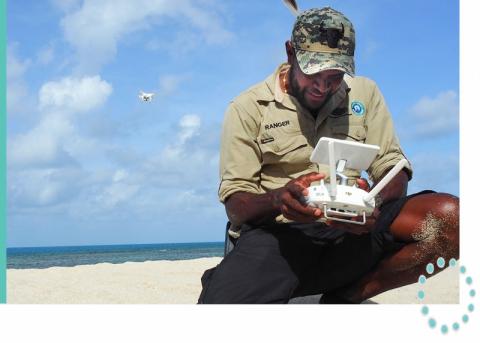
Roles and responsibilities
All Commonwealth agencies
All Heads of Commonwealth agencies have a responsibility to implement the Strategy and to take action/s aligned to the core focus areas of the Strategy. Priority actions should be sequenced to reflect the different context and varying levels of maturity in cultural integrity and Aboriginal and Torres Strait Islander employment across the Commonwealth public sector.
The objectives and priority actions should be integrated into Commonwealth agencies’ workforce planning and strategic documents.
Senior Executive Service
The Senior Executive Service (SES) has an important role to play in implementing the Strategy. This is consistent with their responsibility to provide APS wide strategic leadership that contributes to an effective and cohesive Commonwealth public sector, promote cooperation within and between agencies, including to deliver outcomes across agency and portfolio boundaries.
Leveraging each other and outward facing programs
Collaboration between portfolio departments and small agencies, and cross-sectoral networking and collaboration will be essential in supporting Aboriginal and Torres Strait Islander employees and implementing the Strategy. The APSC will work to encourage this and to bring together agencies at varying stages of progress.
Agency Heads as employers, should look across portfolios to identify outward facing programs and initiatives designed to connect jobseekers with employers and communities with different levels of government, to leverage and adapt to suit the Commonwealth public sector as an employer.
The APSC in partnership with the National Indigenous Australians Agency, the Indigenous SES Network and the cross-agency SES Band 2 working group have an ongoing role for Strategy implementation.
The SES Band 2 working group or a similar cross-agency group will meet regularly to share information about better practices and identify challenges and potential solutions to assist with implementation.
Australian Public Service Commission
The APSC will focus on working with Commonwealth agencies to assist in the delivery of Strategy priorities. The APSC will encourage change across the Commonwealth public sector by supporting the implementation of the Strategy, while responding to emerging expectations of Government and agency heads.
Over the life of the Strategy the APSC will work with Commonwealth agencies to:
- Draw on the diversity of thought, knowledge, expertise and experience across the system, identifying partner agencies best placed to work with the APSC to develop and then deliver initiatives on behalf of other Commonwealth agencies.
- Connect the many diverse players in the system, including Aboriginal and Torres Strait Islander peoples from the public sector, private sector, industry and academic institutions.
- Establish a range of forums and mechanisms to share good practice outcomes and to provide an ongoing assessment of the effectiveness of the implementation of the Strategy.
- Co-design:
- Inclusive recruitment practices removing complexity and creating flexible pathways, including pathways for interns and cadets to advance through to graduate programs.
- Culturally appropriate professional development initiatives and opportunities for Aboriginal and Torres Strait Islander employees at all levels.
- Initiatives to increase employment opportunities in program and policy development for Aboriginal and Torres Strait Islander peoples in regional Australia with the option of flexible pathways for progression.
- Data collection and reporting mechanisms to capture a whole of Commonwealth public sector perspective.
- Improve the recruitment experience by streamlining the requirements relating to
Confirmation of Heritage for Aboriginal and Torres Strait Islander peoples by:
- Investigating the legislative requirements for Confirmation of Heritage and work with Commonwealth agencies to standardise the requirements across the Commonwealth public sector.
- Explore options that allow Aboriginal and Torres Strait Islander applicants to record their Confirmation of Heritage once, eliminating the need to provide evidence when applying for roles advertised as Affirmative Measure—Indigenous employment.
- Explore options to standardise cultural leave provisions in Commonwealth agencies enterprise agreements.
- Evaluations of the Strategy in 2022 and 2024.
Accountability
To affect positive change, there needs to be accountability in progressing the objectives of the Strategy. Shared responsibility and accountability at all levels is critical to successful outcomes.
All Heads of Commonwealth agencies are responsible for supporting the Strategy’s objective of increasing the representation of Aboriginal and Torres Strait Islander employees at all levels, by taking action to strengthen their workforce strategies, policies and work practices.
All Commonwealth employees are encouraged to take action to support the implementation of the Strategy in their agency.

Commonwealth Aboriginal and Torres Strait Islander Workforce Strategy 2020–24
Implementation deliverables
| Deliverables | Action Lead/s | Projected delivery date |
|---|---|---|
| Develop a comprehensive implementation plan and evaluation framework to support effective implementation of Strategy deliverables. | APSC | 2020 |
| In consultation with Portfolio representatives, define Portfolio coordinator role and develop guidance and support material. | APSC and Portfolios representatives | 2020 |
| Conduct an upgrade to the Indigenous Graduate recruitment program to expand Graduate recruitment and improve Graduate recruitment experience. | APSC in partnership with Defence | 2020 |
| Deliver mobility arrangements including opportunities with State Governments, NGO’s and the private sector to support an uptake in mobility for regionally-based Aboriginal and Torres Strait Islander employees. | APSC | 2020 |
| Establish a central repository of Cultural Capability providers and training initiatives that can be accessed by all Commonwealth agencies. | APSC | 2020 |
| Conduct an upgrade to the Indigenous Professionals recruitment program to support the engagement or promotion of Aboriginal and Torres Strait Islander peoples into middle management and more senior roles. | APSC and Agencies | 2020 |
| Conduct a review of Commonwealth policies and guidelines relating to Indigenous recruitment. The review will ensure alignment with key focus areas, appropriate guidance for panel members and ensure identified recruitment and career development barriers are addressed. | APSC | 2021 |
| Review the Commonwealth Aboriginal and Torres Strait Islander Cultural Capability Framework to ensure it encompasses the full breadth of cultural integrity. | APSC in partnership with National Indigenous Australians Agency, Australian Institute of Aboriginal and Torres Strait Islander Studies, and Indigenous SES network | 2021 |
| Review the legislative requirements for Confirmation of Aboriginal and/or Torres Strait Islander Heritage and explore a standardised WOAG approach. | APSC | 2021 |
| Review all WOAG Indigenous recruitment programs to identify and remove barriers for inclusive streamlined recruitment practices and career advancement. | APSC and Agencies | 2021 |
| In collaboration with Agency representatives, develop a public sector Aboriginal and Torres Strait Islander Employee Value Proposition, which aligns to the WOAG Employee Value Proposition identified in the APS Review. | APSC and Agencies | 2021 |
| In consultation with Agencies, implement a consistent brand for WOAG Indigenous recruitment programs (Indigenous Careers). | APSC and Agencies | 2021 |
| Agencies to ensure they have a Reconciliation Australia endorsed Reconciliation Action Plan in place. | Agencies | 2021 |
| In collaboration with agencies, investigate culturally appropriate professional development initiatives for APS 3/4 employees. | APSC and Agencies | 2021 |
| In consultation with Portfolios and/or Agencies develop and deliver a career development framework aimed at actively supporting career management for Aboriginal and Torres Strait Islander employees. | APSC and Agencies | 2021 |
| Portfolios and/or Agencies to review all current recruitment policies and practices to ensure alignment with key focus areas and APSC provided guidance. | Portfolios and/or Agencies | 2021 |
| Explore options for a proposal to Government in 2021 to implement a ‘regional hub’ supporting expanded decentralisation and increased employment and career development opportunities in regional and remote Australia. | APSC and agencies | 2021 |
| Portfolios and/or Agencies to ensure all APS Aboriginal and Torres Strait Islander employees have access to appropriate professional mentors. | Agencies | 2022 |
| Agencies to integrate targets and actions supporting the Strategy into agencies’ workforce planning and strategic documents. | Agencies | 2022 |
| Agencies to improve their workforce planning capabilities and link this to the career management of their Aboriginal and Torres Strait Islander workforce. | Agencies | 2022 |
| Deliver an Interim Evaluation to measure progress and identify areas of strengths and future priority needs in order to achieve the outcomes of the Strategy. This will include reviewing Portfolio target status. | APSC | 2022 |
| Continue to deliver the HR Inclusion Forums as a way of building cross agency innovation and information sharing networks. | APSC | Biannually |
| Explore options to standardise cultural leave provisions in Commonwealth agency enterprise agreements. | Agencies | In-line with Agency specific Enterprise Agreement Bargaining timeframes |
About the artist
Krystal Hurst is a Worimi Artist and Creative Director of Gillawarra Arts, originating from Taree on NSW’s mid north coast. Krystal is a jewellery designer, painter, printmaker and workshop facilitator whose arts practice is centred on ‘a way of being’ whilst reinvigorating and strengthening culture.
Her inspiration derives from Country, memories, stories and community integrated in an innovative and contemporary way. Krystal was awarded ACT NAIDOC Artist of the Year and in 2019 she became the second ever contemporary jewellery finalist in the prestigious Telstra National Aboriginal and Torres Strait Islander Art Awards.
1Council of Australian Governments December 2018, Draft set of targets closingthegap.pmc.gov.au/draft-targets-fordiscussion
2 Statement on the Closing the Gap Refresh, 12 December 2018.
3 “…trauma-informed is about supporting people to feel safe enough in their interactions with services. To build trust, and help people overcome their fear and sense of betrayal.” www.blueknot.org.au/Workers-Practitioners/For-Health-Professionals/Resources-for-Health-Professionals/Trauma-Informed-Care-and-practice



